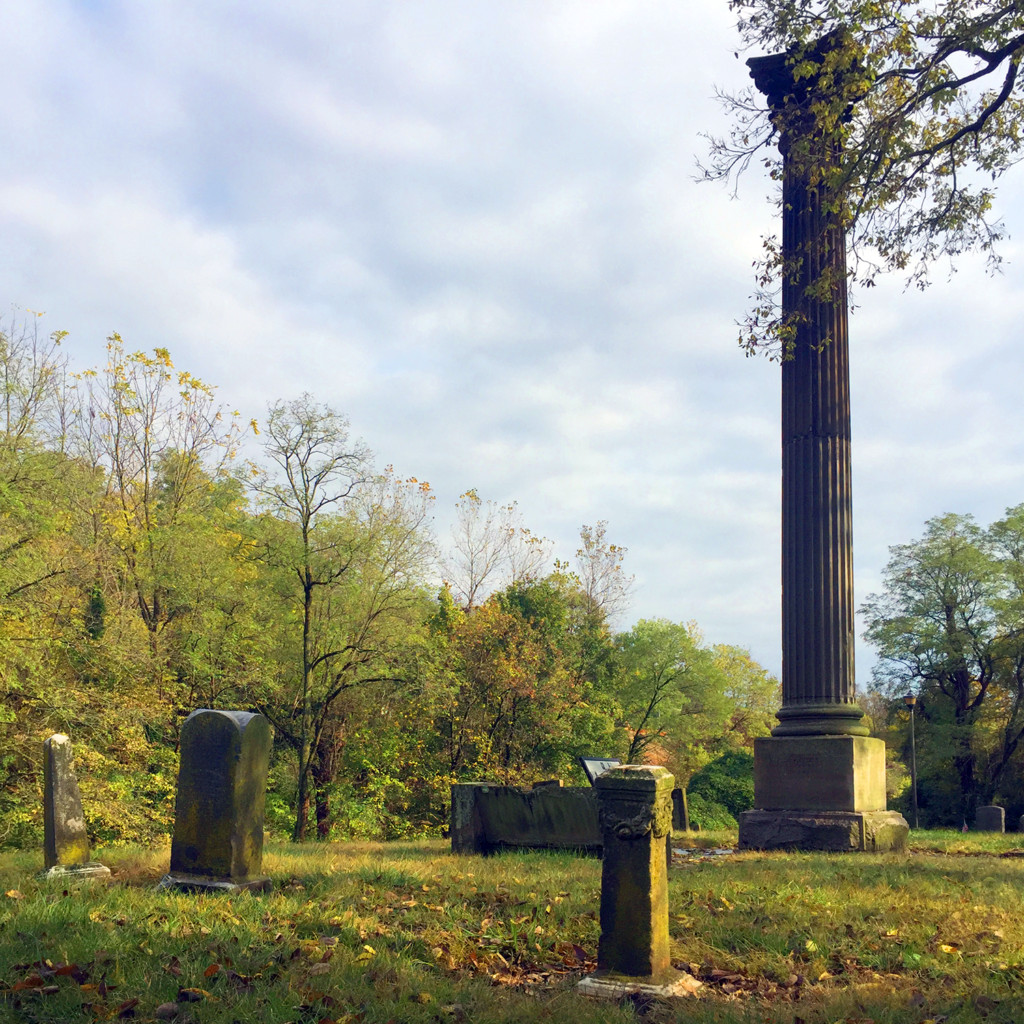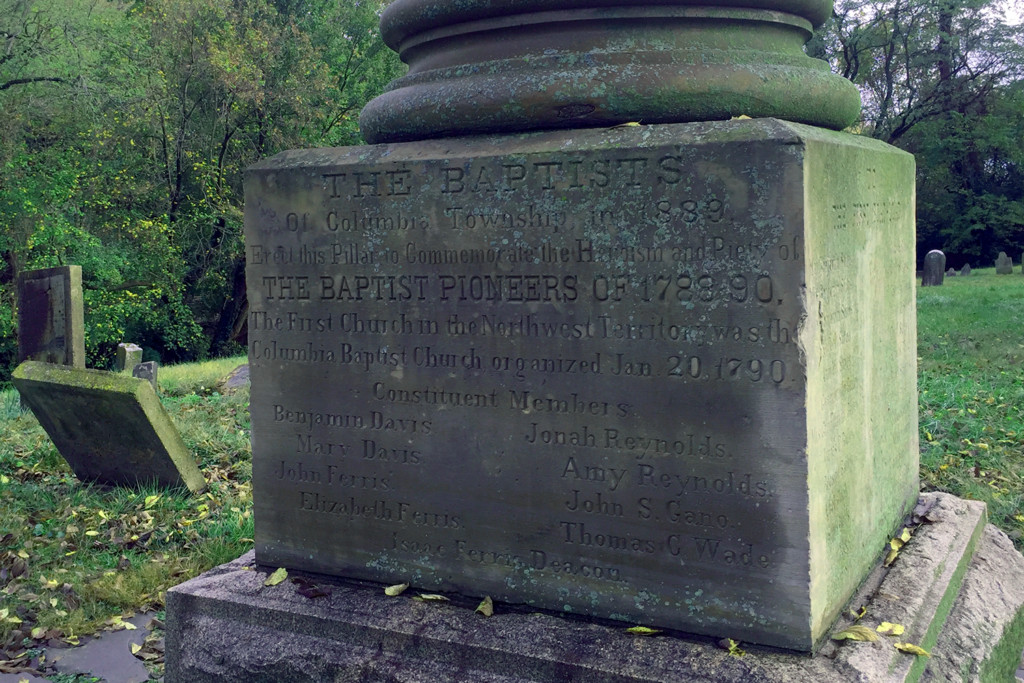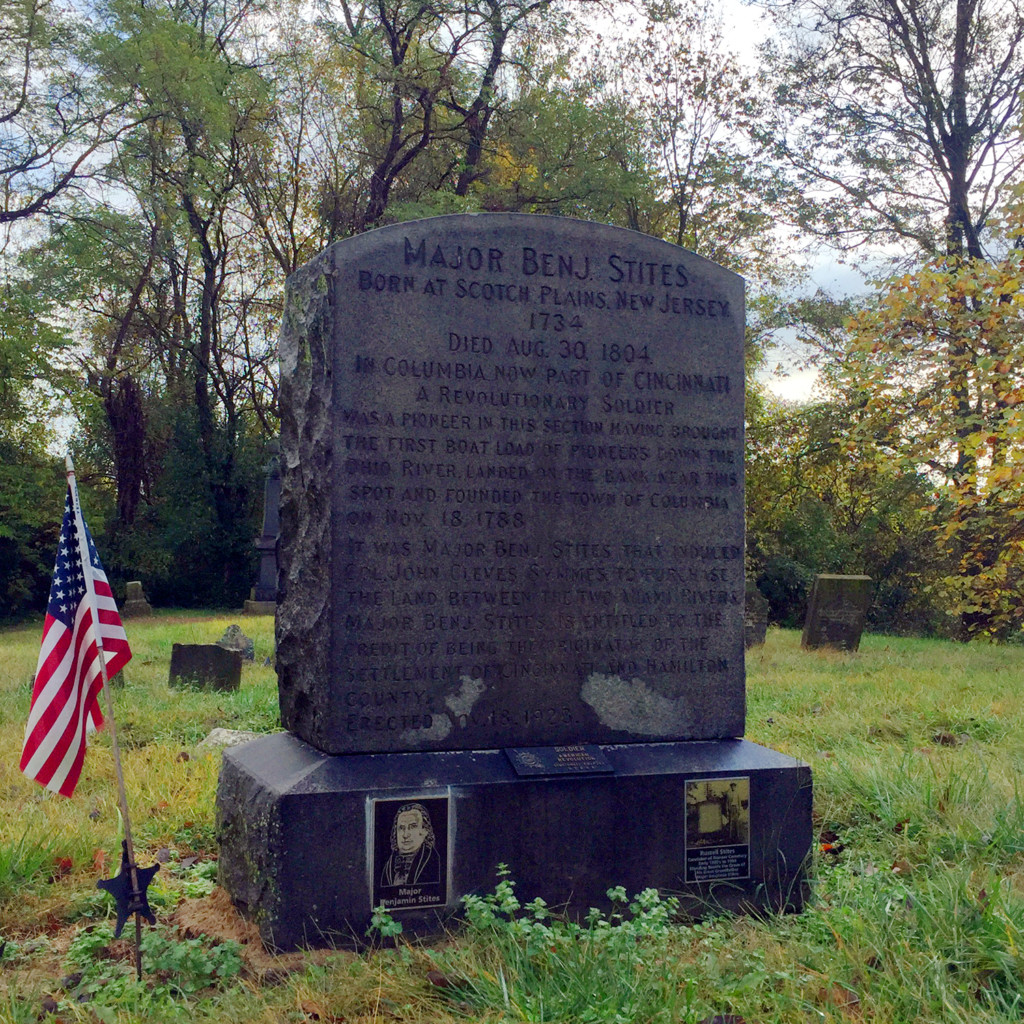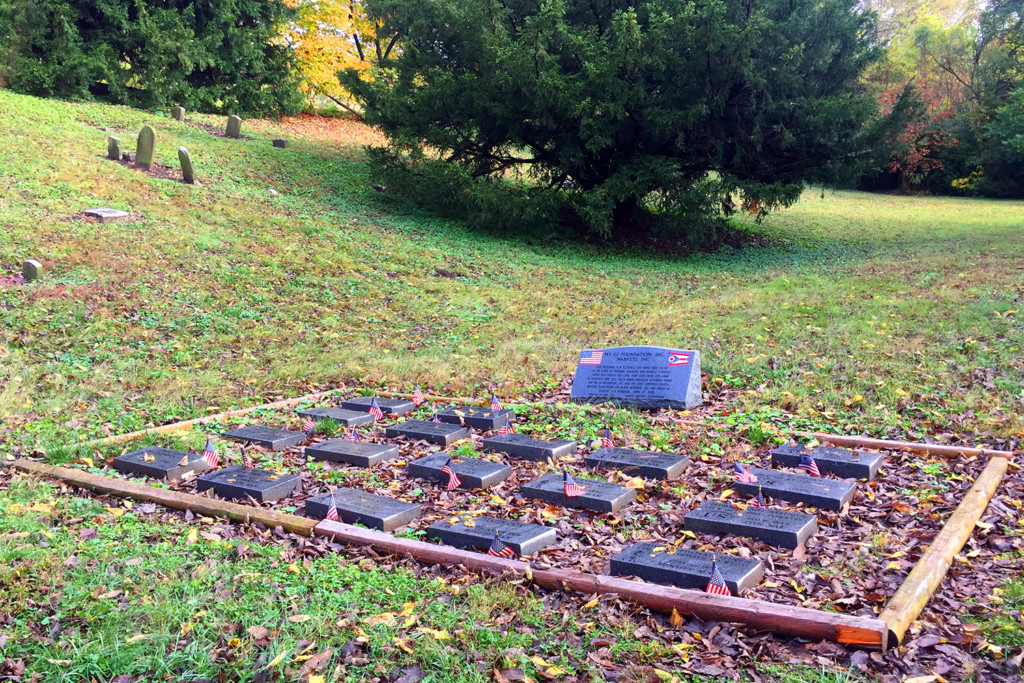Pioneer Memorial Cemetery, nestled on a gentle hill near Lunken Airport, stands as a silent testament to Cincinnati’s earliest days. Maintained with care by the Cincinnati Parks Department, this historic site in Ohio’s Hamilton County marks the location of the region’s oldest graveyard. Its story is deeply intertwined with the first European settlement in the area, predating even the city of Cincinnati itself and offering a poignant glimpse into the lives of pioneers and pivotal moments in American history. The cemetery’s grounds were once part of the Columbia Baptist Church, established in 1790, just a few years after settlers first arrived in Columbia, now the charming Cincinnati neighborhood of Columbia-Tusculum.
 Historic marker at Pioneer Memorial Cemetery entrance
Historic marker at Pioneer Memorial Cemetery entrance
Within Pioneer Memorial Cemetery lie numerous tombstones, some weathered by centuries and bearing inscriptions from as far back as the 1700s. This solemn ground serves as the final resting place for soldiers who served in both the American Revolutionary War and the Civil War, connecting it directly to the nation’s formative periods. Remarkably, Pioneer Memorial Cemetery is believed to be the sole surviving landmark from the very first European settlement in this part of Ohio, making it an essential site for understanding the region’s origins.
Burial activity at this location likely commenced around 1790, coinciding with the establishment of the Columbia Baptist Church. Among the oldest marked graves is that of Phebe Stites, the infant daughter of Captain Hezekiah Stites. Phebe’s tombstone records her passing on March 14, 1797, at just five months old, offering a tangible link to the personal stories of early settlers.
Informative plaques within the cemetery highlight its significance to the Baptist faith. The first meeting house of the Columbia Baptist Church, recognized as the oldest Baptist church in Ohio, was originally situated here. Stephen Gano played a crucial role in establishing the Columbia Baptist Church and served as its inaugural preacher, with his brother John S. Gano among the founding members. In 1792, this site also became the location of the first Baptist ordination service in the Northwest Territory, presided over by their father, John Gano, further cementing its place in religious history.
John Smith, an early settler, became the first full-time pastor of the Columbia Baptist Church and emerged as a significant figure in Ohio’s path to statehood. He was an advocate for Ohio’s statehood, participated in the first Territorial Assembly in 1798, and became Ohio’s first US Senator, serving from 1803 to 1808. His political career led him to become a trusted friend and advisor to President Thomas Jefferson, demonstrating the influence of early figures connected to Pioneer Memorial Cemetery.
 Tall Corinthian pillar monument at Pioneer Memorial Cemetery
Tall Corinthian pillar monument at Pioneer Memorial Cemetery
 Base of the Corinthian pillar monument showing details
Base of the Corinthian pillar monument showing details
An eye-catching feature within the cemetery is a tall Corinthian pillar. This architectural element was salvaged from the old Cincinnati Post Office building, a grand structure erected in 1856 and later demolished. In 1888, the pillar was relocated to Pioneer Memorial Cemetery, adding a unique and historically resonant monument to the grounds.
 Memorial to Major Benjamin Stites, founder of Columbia
Memorial to Major Benjamin Stites, founder of Columbia
A dedicated memorial honors Major Benjamin Stites (1734-1804), the founder of Columbia. This monument, erected in 1923, recognizes Stites’ foundational role in establishing the early settlement that preceded Cincinnati, further emphasizing the cemetery’s connection to the region’s origins.
 Anthony Wayne Parkway marker at Pioneer Memorial Cemetery
Anthony Wayne Parkway marker at Pioneer Memorial Cemetery
The name “Mad Anthony” Wayne resonates in local street names like Mad Anthony Street in Northside and city names such as Ft. Wayne, Indiana. Both are named after Anthony Wayne, a General whose aggressive military leadership during the American Revolutionary War earned him his famous nickname. Wayne later commanded forces during the Northwest Indian War, achieving a decisive victory at the Battle of Fallen Timbers in Maumee, Ohio, in 1794. This victory paved the way for the Treaty of Greenville in 1795, negotiated by Wayne. This treaty ceded a vast portion of Ohio to the United States, directly enabling Ohio’s entry into the Union in 1803.
In 1944, commemorating the 150th anniversary of the Treaty of Greenville, the Anthony Wayne Memorial Joint Legislative Committee was formed. Their mission was to establish a network of parks and memorials linked by roadways, celebrating the events leading to Ohio’s statehood. By 1957, in collaboration with the Ohio Department of Highways, a 450-mile Anthony Wayne Parkway was marked across 23 counties, stretching from Cincinnati to Toledo. These roads largely followed the routes of military campaigns and connected significant battle sites and fortifications. Although the Anthony Wayne Parkway Board dissolved in 1993, remnants of this initiative remain, including a marker prominently placed at the entrance to Pioneer Memorial Cemetery, linking it to this broader historical narrative.
 Close-up of a weathered headstone in Pioneer Memorial Cemetery
Close-up of a weathered headstone in Pioneer Memorial Cemetery
Intriguingly, in 1958, archaeological findings revealed that the Pioneer Memorial Cemetery site was once the location of a Native American village dating back to the Woodland period (800 BC-1200 AD). The presence of the cemetery has prevented any extensive excavation, leaving our understanding of this pre-European settlement limited. Known details about the Woodland period in the Ohio Valley describe a time marked by the emergence of pottery, the cultivation of plants, settled village life, the construction of mounds, and an accelerated pace of cultural development.
During this era, early inhabitants of Ohio were gardener-farmers, living in smaller communities. By the Late Woodland period, villages grew larger, potentially housing up to 100 individuals. Pre-contact Native Americans in the Ohio Valley cultivated a diverse range of local crops, including squash, sunflower, erect knotweed, lamb’s quarter, and maygrass, showcasing a sophisticated understanding of agriculture in the region long before European arrival.
Pioneer Memorial Cemetery suffered from neglect for many years until Frederick L. Payne, then Supervising Horticulturalist for the Park Board, initiated a restoration project in 1967. Payne’s dedication extended to historical documentation; he compiled a comprehensive two-volume record detailing the cemetery’s history. This valuable document, now preserved at the Cincinnati Historical Society, lists identified burials since 1790 and includes photographs of all grave markers during the restoration, ensuring a lasting record of the site’s heritage.
Frederick L. Payne retired as Director of Parks in 1987. To honor his significant contributions to the Cincinnati Parks and particularly his work at Pioneer Memorial Cemetery, a simple colonial garden was established near the cemetery entrance, offering a peaceful tribute to his preservation efforts.
 Monument honoring Black veterans at Pioneer Memorial Cemetery
Monument honoring Black veterans at Pioneer Memorial Cemetery
In 2019, a collaborative effort between the National Association for Black Veterans Chapter #68 and the My GI Foundation resulted in the installation of 18 new headstones and a substantial monument. This monument specifically honors Black veterans from 1790 to 1867 who are buried within Pioneer Memorial Cemetery. This addition underscores another layer of historical significance to the site, recognizing the contributions of Black veterans in the early history of the region and nation.
Pioneer Memorial Cemetery holds a distinguished place on the National Register of Historic Places, officially listed under its historic name, Columbia Baptist Cemetery. Encompassing 2.2 acres, it is located at 333 Wilmer Ave., just north of Davis Lane. This enduring landmark invites visitors to reflect on the lives of Cincinnati’s earliest pioneers and the rich tapestry of history woven into this sacred ground.
References: (From original article – if any were explicitly listed, they would be placed here)

